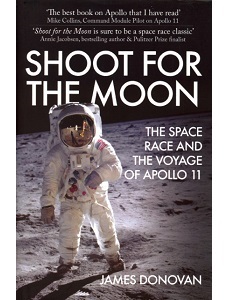This year marks the 50th anniversary of Apollo 11, the first manned lunar landing mission, and this book commemorates the event by telling “the epic story of the astronauts, flight controllers and engineers who made it happen”. It does so in some 390 pages accompanied by another 60 pages of chapter notes, a bibliography and an index, and is illustrated by a 24-page colour photo insert.
Given that similar commemorative books were published to mark the 25th, 30th and 40th anniversaries, it seems fair to ask whether this one adds anything new. On the other hand, one has to realise that new books are often aimed at a new generation of readers, who may not be aware of the predecessor volumes, and are written to keep the subject alive. Moreover, in an era when no-one is travelling to the Moon – the status quo for the past half-century – it’s important to keep stoking the fire!
The book’s subtitle – The Space Race and the Extraordinary Voyage of Apollo 11 (abbreviated on the cover) – gives some indication of its coverage, but it’s important to note that this is not a blow-by-blow account of the Apollo 11 mission. That consumes only the final 90 pages or so of Part IV, entitled “Down”. Three other parts – “Up”, “Around” and “Out” precede this and form the “Space Race” part of the subtitle.
Seasoned readers of Apollo books will spot the familiar pattern from the first words of the first chapter: “One Saturday morning in October 1957, a 14-year-old boy in the small farming town of Fremont, Iowa, woke up to find the world a different place.” The event, of course, was Sputnik, but the boy wasn’t, as readers might expect, one of the astronauts: it was Steve Bales, later guidance officer for Apollo 11. We don’t pick up on Bales’ story for another 150 pages, by which time the general reader will have forgotten about him, but the author clearly feels that if this storytelling technique is good enough for filmmakers, it is good enough for him.
And, you know, it’s good enough for me too; this is a well-researched and written book. In the final analysis, however jaded we get about continual re-heatings of a well-cooked story, it’s actually quite a good story and there’s always something new to learn. Take, for example, a single quote from Armstrong on ‘landing abort rules’: following a long debate about insufficient data during the landing phase, Armstrong shook his head, saying, “You must think I’m going to land with the window shades down”. History shows, of course, that he was most certainly looking out of the window!
So, regarding commemorations of the most audacious example of exploration in the history of mankind, let’s keep stoking the fire... at least until someone lights another one.











